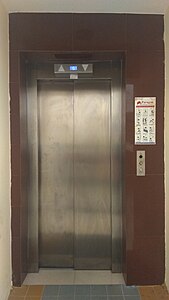claustrophobia
| Classification according to ICD-10 | |
|---|---|
| F40.2 | Specific (isolated) phobias |
| F40.2 | claustrophobia |
| ICD-10 online (WHO version 2019) | |
Claustrophobia ( , Latin claustrum "lock, bolt, lock", Greek φόβος phóbos " fear ", " phobia "), rarely also called fear of space , is a specific ("isolated") anxiety disorder . In those affected, it expresses itself as a fear of being actually or perceived to be locked in or of the mere presence of narrow or closed spaces. In extreme cases, a closed door can lead to a panic attack with hyperventilation and sweating.
Colloquially claustrophobia is as claustrophobic referred to as the psychology the term claustrophobia to the agoraphobia applies, the fear of public places or large spaces (agoraphobia F40.0 according to standard ICD-10 ).
Occurrence
Claustrophobic fears are common in everyday life. Estimates assume that around 7 percent of the population suffers from claustrophobic fears, depending on the precise definition, even more.
They occur in elevators, buses and trains, but also in department stores, cinemas and in general in crowds. For those affected, the phobia is associated with more or less severe restrictions in daily life, depending on the severity. In some cases, elevators are avoided in high-rise buildings and the stairs are used instead, rail, bus and air travel are in some cases not possible, as is the use of tunnels, entering small rooms (such as changing rooms, sometimes also small rooms, basements, caves); sometimes tight clothing triggers the reaction.
Claustrophobia is also of practical importance in MRI examinations, as the patient has to lie in a tube for up to 30 minutes and remain calm in order to ensure sufficient image quality. Because of the severely restricted freedom of movement and the unusual operating noises, this triggers anxiety even with otherwise less pronounced claustrophobia. In a study by Murphy and Brunberg, during a randomly chosen seven-week study period of 939 patients who were 18 years of age or older, 134 people (14.3%) required some form of medicinal sedation (including general anesthesia ) due to pronounced anxiety reactions in order to prevent the MRI scan could be performed. With "open MRT systems" this fact is now taken into account at individual examination centers.
treatment
The current treatment guideline recommends behavioral psychotherapy with exposure methods . In behavior therapy , the detection of interpersonal behavior patterns also plays a major role. If in vivo exposure is not available or possible, virtual reality exposure methods are also recommended.
There is no evidence of effectiveness for psychotherapies and psychoanalysis based on depth psychology. Here is the uncovering of hidden, not yet understood, i.e. H. unconscious motives, in the foreground of the treatment - the symptom is understood as an attempt to compromise.
The effectiveness of psychotropic drugs in the treatment of claustrophobic fears has not yet been proven. Antidepressants such as SSRIs or tricyclics are prescribed .
literature
- Jürgen Margraf , Silvia Schneider, Gunther Meinlschmidt (eds.): Textbook of behavior therapy. Volume 1, Springer Verlag, Berlin 2000, ISBN 3-540-66439-4 .
- C. Botella, RM Baños, C. Perpiña, H. Villa, M. Alcaniz, A. Rey: Virtual reality treatment of Claustrophobia: a case report. In: Behavior Research and Therapy. 1998, 36, pp. 239-246.
- Donald Meltzer: The Claustrum. An investigation into claustrophobic phenomena. Brandes & Apsel, Edition diskord, Tübingen 2005, ISBN 3-86099-567-7 .
Web links
Individual evidence
- ↑ a b Margraf, Jürgen; Schneider, Silvia (Hrsg.): Textbook of behavior therapy, volume 2 Psychological therapy for indications in adulthood . 4th edition. tape 2 . Springer, Heidelberg 2018, ISBN 978-3-662-54908-7 , pp. 670 .
- ↑ Alfons O. Hamm: Specific phobias . In: PSYCH up2date . tape 11 , no. 03 . Thieme, Stuttgart 2017, p. 223-238 , doi : 10.1055 / s-0043-100487 .
- ↑ B. Bandelow et al .: S3 guidelines for the treatment of anxiety disorders. (PDF) In: AWMF. April 15, 2014, accessed August 17, 2019 .
